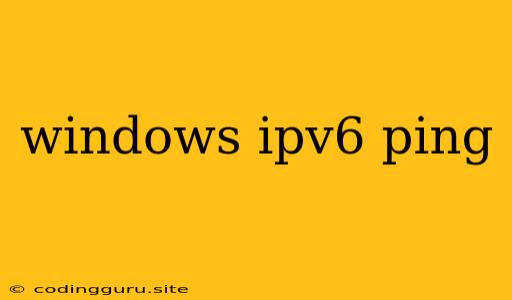Understanding and Troubleshooting IPv6 Connectivity Issues on Windows
In the modern digital landscape, the transition to IPv6 is becoming increasingly crucial. While IPv4 has served us well, it is facing limitations due to its dwindling address space. IPv6, with its vast address pool, promises to address these concerns. However, this transition can sometimes lead to connectivity challenges, especially for users accustomed to IPv4. One such challenge is configuring and troubleshooting IPv6 connectivity on Windows.
Why is IPv6 Important?
IPv6 offers several advantages over its predecessor, including:
- Vast Address Space: IPv6 utilizes 128-bit addresses, providing an almost limitless number of unique addresses, effectively eliminating address exhaustion concerns.
- Enhanced Security: IPv6 incorporates built-in security features, making it inherently more secure than IPv4.
- Simplified Network Management: IPv6 simplifies network management by streamlining address allocation and configuration.
- Support for Emerging Technologies: It paves the way for future technologies like the Internet of Things (IoT) and cloud computing.
Troubleshooting IPv6 Connectivity on Windows
When encountering IPv6 connectivity issues on your Windows machine, there are several troubleshooting steps you can take:
1. Check Your Network Adapter Settings
- Verify IPv6 Enablement: Open the Network and Sharing Center, navigate to Change adapter settings, and right-click your network connection. Select Properties. Look for Internet Protocol Version 6 (TCP/IPv6). Ensure it is enabled.
- Obtain IPv6 Address Automatically: Within the Internet Protocol Version 6 (TCP/IPv6) properties, ensure Obtain IPv6 address automatically and Obtain DNS server address automatically are selected.
2. Test IPv6 Connectivity with Ping
The ping command is a powerful tool for testing network connectivity. You can use it to verify IPv6 communication by pinging an IPv6 address.
Example:
ping -6 ::1
- ::1 represents the loopback address for IPv6, which tests your local network stack.
- ping -6 instructs the command to use IPv6.
If the ping is successful, you will see a series of replies. If not, this indicates an issue with your local IPv6 configuration.
3. Verify Your Internet Service Provider (ISP) Support
Your ISP needs to support IPv6 for you to establish a connection. Contact your ISP to confirm if they offer IPv6 support.
4. Check Your Router Settings
- Enable IPv6 on your Router: Many routers have built-in support for IPv6. Access your router's web interface, typically through its IP address, and locate the IPv6 settings. Ensure IPv6 is enabled.
- Configure IPv6 Addressing: Configure your router to allocate IPv6 addresses to connected devices. This might involve setting up a specific IPv6 prefix and addressing scheme.
5. Examine Firewall Rules
Both your Windows firewall and your router's firewall might have rules that block IPv6 traffic. Review these rules and ensure they don't prevent IPv6 connectivity.
6. Consider DNS Issues
DNS (Domain Name System) servers are essential for resolving domain names into IP addresses. Make sure your DNS server is properly configured and supports IPv6.
7. Utilize Diagnostic Tools
Windows provides built-in network diagnostic tools. Run these tools to identify potential issues with your IPv6 configuration:
- Network Troubleshooter: Access it through Settings > Network & Internet > Status > Network Troubleshooter.
- Command Prompt: Use commands like
ipconfig /allandnetsh interface ipv6 show configto gather detailed information about your IPv6 configuration.
Common Errors and Resolutions:
- Error: Destination host unreachable: This error indicates that the ping request failed to reach the target host. Check the IPv6 address you are pinging and confirm that it is correct.
- Error: General failure: This error suggests a more general network issue. Check your network connection, firewall rules, and router settings.
Conclusion:
Troubleshooting IPv6 connectivity on Windows requires a methodical approach. By understanding IPv6 concepts and using the troubleshooting techniques outlined above, you can identify and resolve issues, ensuring a seamless transition to the future of internet connectivity.
